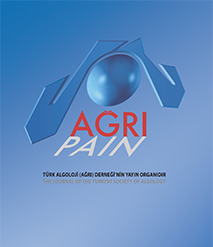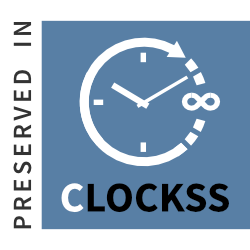Quick Search
Volume: 18 Issue: 4 - 2006
| 1. | Pain and pain behavior Gülcan Güleç, Sacit Güleç PMID: 17457708 Pages 5 - 9 Pain is an unpleasent sensory and emotional experience associated with actual or potential tissue damage. Behavioral manifestation of pain, distress, and suffering have been characterized as pain behaviors. Pain behavior is the way individuals think, feel, and act in relation to their pain status. Pain behaviors are either adaptive or pathological, as when the pain behavior is disproportionate to the objective pathology. It’s reported that when pain behavior exists in patients with pain, a psychiatric disorder might to increase pain. The relation between psychological factors and pain behavior is investigated in several studies. |
| 2. | Adjuvant analgesics in pain management Selami Ateş Önal PMID: 17457709 Pages 10 - 23 The term adjuvant analgesics describes any drug with a primary indication other than pain, but with analgesic properties in some painful conditions. Adjuvant analgesics often are administered as first-line drugs in the treatment of chronic non-malignant pain. The group includes numerous drugs in diverse classes. Some adjuvant analgesics possess analgesic properties in several types of pain, whereas others are specific for neuropathic pain, or nociceptive pain. Antidepressants, anticonvulsants, neuroleptics, antiarrythmics, antihistaminics, NMDA receptor-antagonists, steroids, muscle relaxants, bisphosphonates, and radiopharmaceuticals are adjuvant agents. This article reviews the evidence supporting the use of adjuvant analgesics for the treatment of pain and emphasizes medical dosages, side effects, and drug interactions. |
| 3. | Migraine And Cortical Spreading Depression Murat Alemdar, Macit Selekler PMID: 17457710 Pages 24 - 30 Migraine is an episodic headache disorder accompanied by various neurological, gastrointestinal and autonomic changes. In one fifth of the migraineurs, a neurological disturbance (visual, sensory or motor) appears during or before the development of the headache called migraine aura. Cortical spreading depression (CSD) is a transient neuronal depolarization that spreads across unilateral hemisphere from a focus and is followed by a long-lasting depression of neuronal activity. CSD was proposed to be the underlying phenomenon of the migraine aura as it propagates at a similar velocity with visual scotomata and the transient cortical oligemia seen in migraineurs during the aura phase. This data, enabling a better understanding of migraine pathophysiology, will result in new insights into the treatment of other neurological disorders such as cerebrovascular disorders, transient global amnesia, traumatic brain injury, in whose pathophysiology CSD is supposed to take part, beside the treatment of migraine itself. |
| 4. | Transdermal fentanyl for neuropathic pain: case report. Sema Tuncer, Ruhiye Reisli, İnci Kara, Şeref Otelcioğlu PMID: 17457711 Pages 31 - 35 The mechanisms responsible for neuropathic pain are not fully understood. Most treatment modalities are ineffective or insufficient for this important clinical condition. Better understanding of pain mechanisms and opioid drug action has widened the indications for opioids in pain therapy of non-malignant pain including neurophatic pain. In this report of a case a female patient with chronic non-malignant neurophatic pain was followed–up for pain and side effects for approximately fourteen months with the use of transdermal fentanyl (TDF). Pain reduction was good throughout the study. Severe side effects did not occur. TDF was effective and tolerated in the treatment of chronic neuropathic pain of nonmalignant origin. |
| 5. | Investigation of nurses’ pain related knowledge, attitude and clinical decision making skills Serap Özer, Banu Akyürek, Zümrüt Başbakkal PMID: 17457712 Pages 36 - 43 The purpose of this study was to investigate the nurses’ ain related knowledge, attitude and clinical decision making skills. Three instruments were used in the study: (1) Nurses’ Introduction Form, (2) The Nurses' Knowledge and Attitudes Questionnaire and (3) Clinical Decision Making Survey Questionnaire developed by McCaffery and Ferrell was translated into Turkish and used with permission. The results showed that many nurses have inadequate knowledge about pain assessment and management, nurses’ (%47.4) did not observe patient’s behaviors to determine/assess the patient’s intensity of pain and %74.5 of nurses’ did not use pain assessment scales to measure the patient’s pain. |
| 6. | The effect of 3-in-1 femoral nerve block with ropivacaine 0.375% on postoperative morphine consumption in elderly patients after total knee replacement surgery Mehmet Özen, Nurten İnan, Filiz Tümer, Ahmet Uyar, Bülent Baltacı PMID: 17457713 Pages 44 - 50 Total knee replacement (TKR) is one of the most painful orthopedic surgical procedures. This study was aimed to investigate the effect of a single-shot preoperative 3-in-1 femoral nerve block on postoperative pain by using 0.375% ropivacaine, and on the consumption of morphine by using PCA following the TKR surgery. Side effects were also evaluated in this setting. 34 patients were included in this study. Group R (n=17) received a 3-in-1 femoral nerve block (FNB) with 40 ml of ropivacaine %0.375. Group S (n=17) received only a 2 mg loading dose of morphine 30 minutes before the end of surgery, and no block was performed. Both groups received general anesthesia and postoperatively had a PCA pump programmed to deliver morphine.VAS scores at rest, morphine consumption and adverse effects were recorded. Two patients were excluded from each group. Pain scores at 0,1,2,3,4,6,8 postoperative hours were significantly lower in group R in resting position (p<0.05). Group R experienced no pain at the recovery room and this state lasted 8 hours after the surgery while group S reached the acceptable score (VAS ≤ 3) one hour after leaving the recovery room. The morphine requirement was significantly lower in Group R at 12, 18, 24, 48 hr after TKR (p<0.001). Side effects were also lower in this group. Preoperative single-shot 3-in-1 FNB with 40 cc of ropivacaine %0.375 provides better VAS scores, less morphine consumption and fewer side effects in elderly patients when compared to the group with no block. |
| 7. | The prevalence of low back pain and its relationship with household jobs and other factors in a group of women in a rural area in Manisa Pınar Erbay Dündar, Beyhan Cengiz Özyurt, Dilek Özmen PMID: 17457714 Pages 51 - 56 The aims of this cross-sectional study were to determine the prevalence of low back pain and to evaluate the effects of household jobs on low back pain in women living in a rural setting in Manisa. Study population is consisted of 302 women and cluster sampling is performed according to percentage of health center district populations. Participation ratio of this study was 89.1%. Univariete and multivariete risk approach in 95% confidence interval and t test were performed in data analysis. Brief Disability Questionnaire was applied to the study group. Life time and point prevalence of low back pain were determined 79.2% and 34.9% of the study group. Low back pain risk in 95%CI was higher in wrong posture during ironing, heavy load lifting, overweight/obesity and disability 2.2(1.1-4.5), 4.5 (2.1-9.2), 3.8 (1.7-8.3) and 9.2 (4.3-19.7) times respectively.For preventive health measures it is necessary to apply ergonomic working conditions and to give appropriate postural habits to women. |





